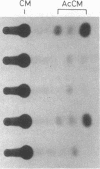Abstract
To elucidate the molecular basis underlying the difference in the mode of gene expression between mouse complement C4 (constitutive) and sex-limited protein (Slp) (testosterone-regulated), we compared nucleotide sequences and transcriptional regulatory activities of the 5'-flanking regions of these two genes. Although the two sequences showed a high degree of overall homology (95%) up to 1.9 kilobases (kb) upstream from the transcription initiation site, the Slp sequence lacked a 31-nucleotide segment containing ACACCC repeats and a 60-nucleotide segment containing ACAC repeats, which are present, respectively, 1.6 kb and 200 base pairs (bp) upstream from the transcription initiation site of the C4 gene. When assayed in human hepatoma-derived HepG2 cells, the 1.8-kb 5'-flanking DNA fragment of the C4 gene demonstrated strong transcriptional activity, whereas the corresponding DNA fragment of the Slp gene showed only negligible activity. By progressive deletion experiments, it was shown that the difference in the constitutive transcriptional activity of the C4 and Slp genes was accounted for by the presence or absence of the positive regulatory domain located between 1700 bp and 400 bp upstream of the transcription initiation site.
Full text
PDF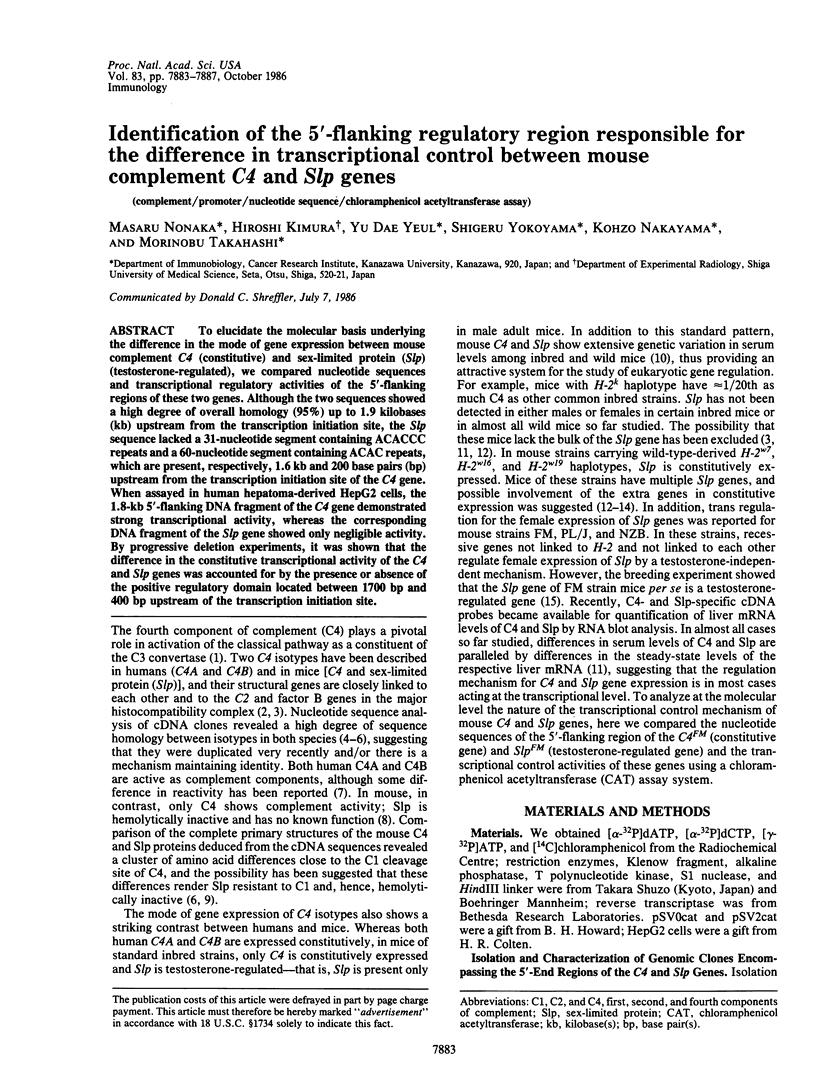
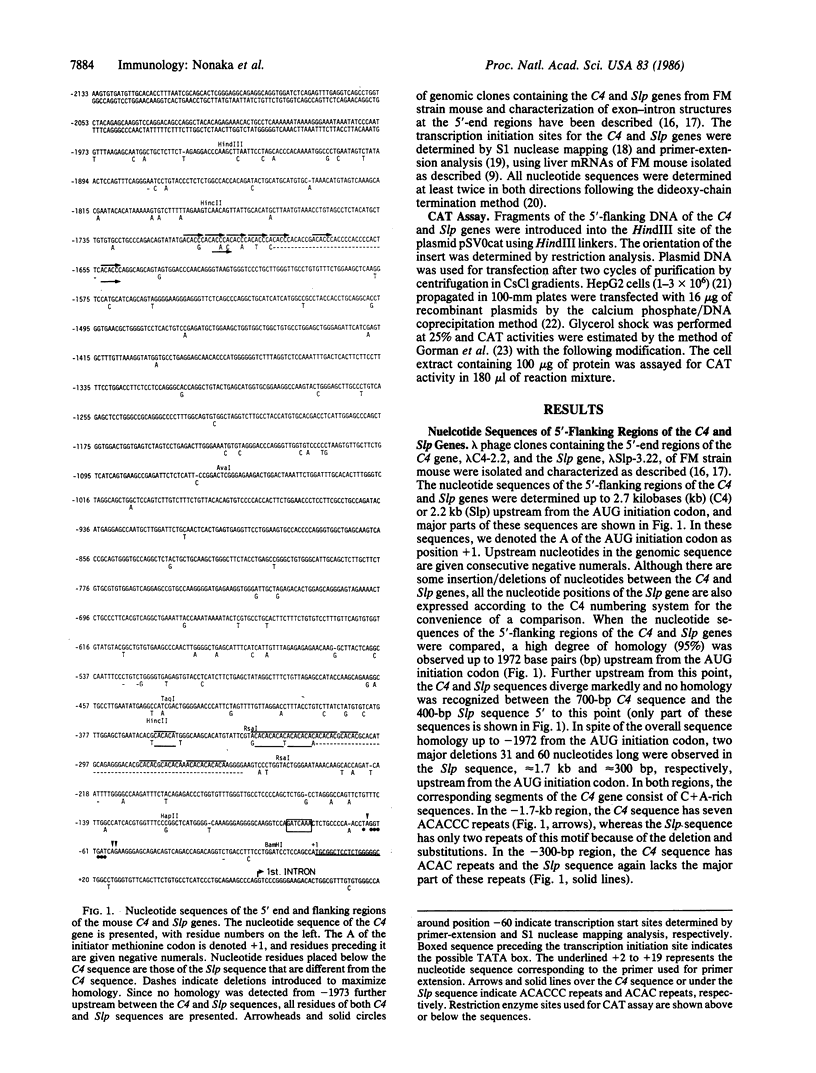
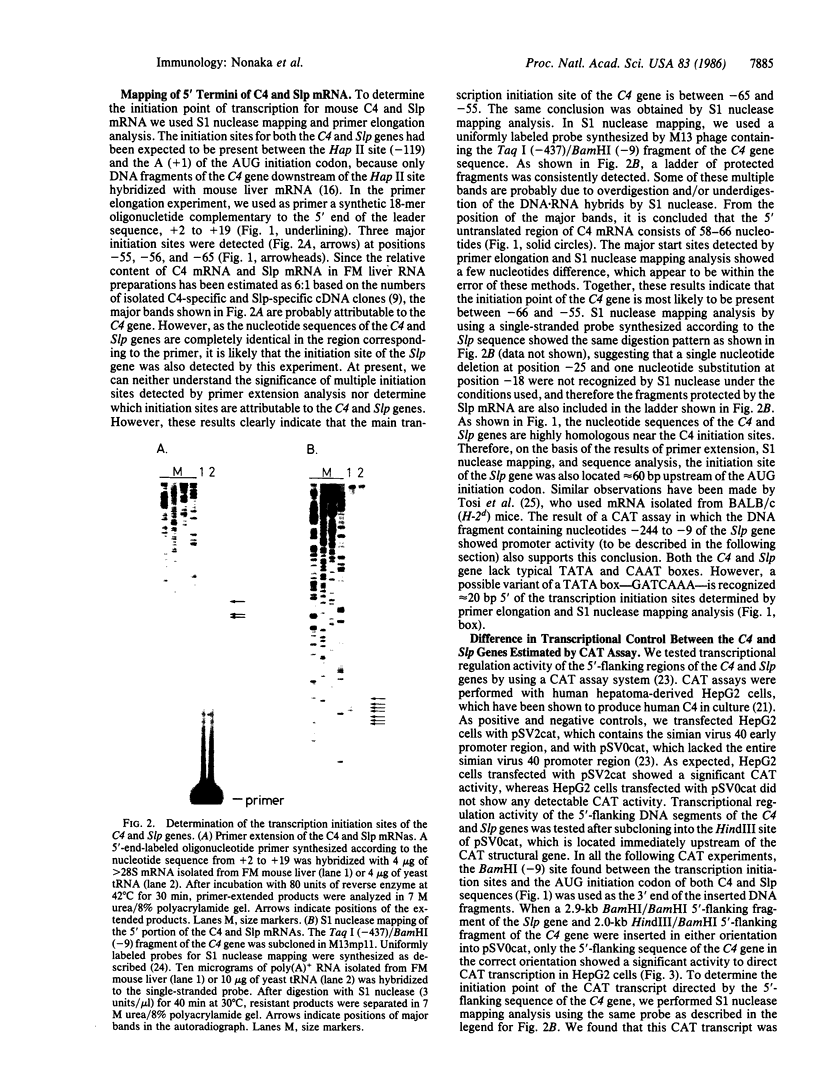
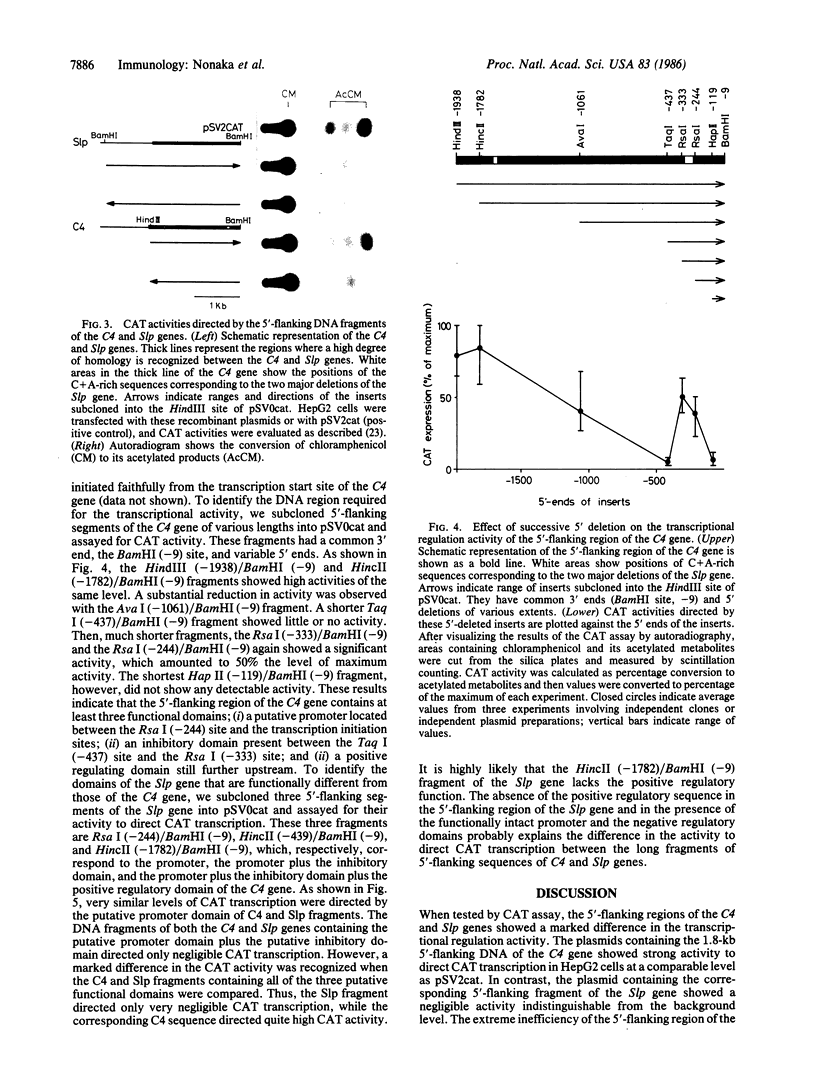
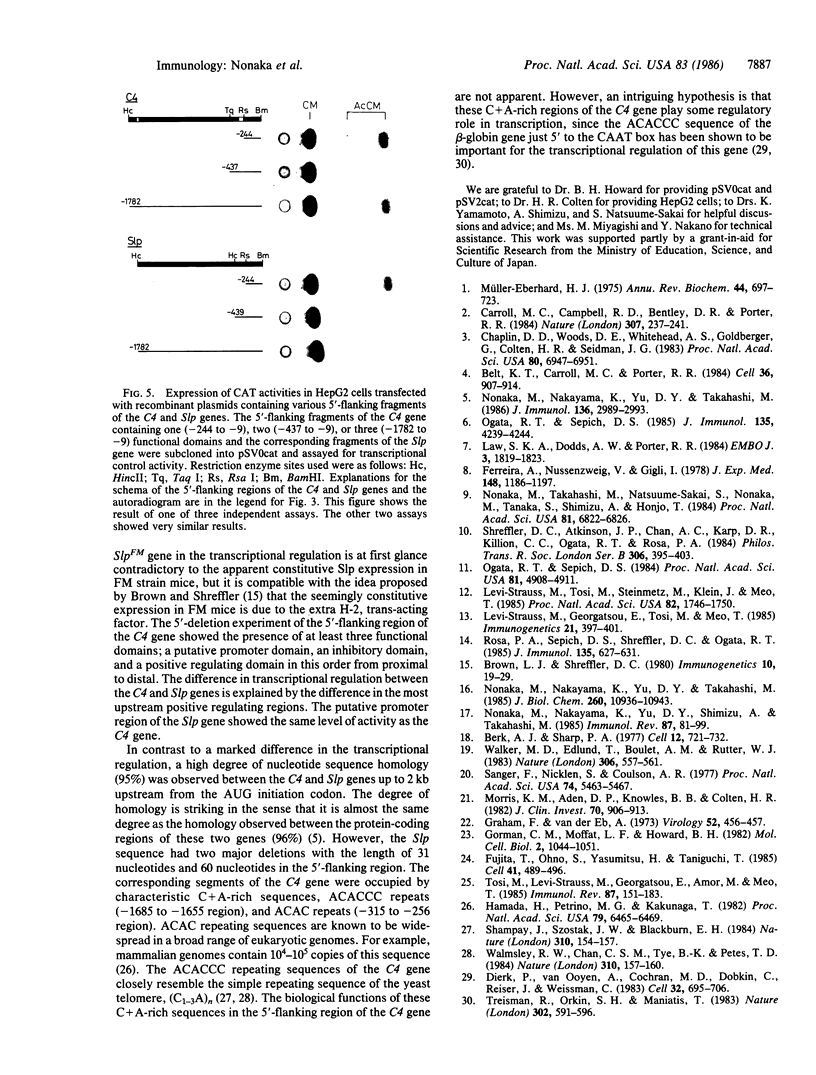
Images in this article
Selected References
These references are in PubMed. This may not be the complete list of references from this article.
- Belt K. T., Carroll M. C., Porter R. R. The structural basis of the multiple forms of human complement component C4. Cell. 1984 Apr;36(4):907–914. doi: 10.1016/0092-8674(84)90040-0. [DOI] [PubMed] [Google Scholar]
- Berk A. J., Sharp P. A. Sizing and mapping of early adenovirus mRNAs by gel electrophoresis of S1 endonuclease-digested hybrids. Cell. 1977 Nov;12(3):721–732. doi: 10.1016/0092-8674(77)90272-0. [DOI] [PubMed] [Google Scholar]
- Brown L. J., Shreffler D. C. Female expression of the H-2-linked sex-limited protein (Slp) due to non-H-2 genes. Immunogenetics. 1980;10(1):19–29. doi: 10.1007/BF01561549. [DOI] [PubMed] [Google Scholar]
- Carroll M. C., Campbell R. D., Bentley D. R., Porter R. R. A molecular map of the human major histocompatibility complex class III region linking complement genes C4, C2 and factor B. Nature. 1984 Jan 19;307(5948):237–241. doi: 10.1038/307237a0. [DOI] [PubMed] [Google Scholar]
- Chaplin D. D., Woods D. E., Whitehead A. S., Goldberger G., Colten H. R., Seidman J. G. Molecular map of the murine S region. Proc Natl Acad Sci U S A. 1983 Nov;80(22):6947–6951. doi: 10.1073/pnas.80.22.6947. [DOI] [PMC free article] [PubMed] [Google Scholar]
- Dierks P., van Ooyen A., Cochran M. D., Dobkin C., Reiser J., Weissmann C. Three regions upstream from the cap site are required for efficient and accurate transcription of the rabbit beta-globin gene in mouse 3T6 cells. Cell. 1983 Mar;32(3):695–706. doi: 10.1016/0092-8674(83)90055-7. [DOI] [PubMed] [Google Scholar]
- Ferreira A., Nussenzweig V., Gigli I. Structural and functional differences between the H-2 controlled Ss and Slp proteins. J Exp Med. 1978 Nov 1;148(5):1186–1197. doi: 10.1084/jem.148.5.1186. [DOI] [PMC free article] [PubMed] [Google Scholar]
- Fujita T., Ohno S., Yasumitsu H., Taniguchi T. Delimitation and properties of DNA sequences required for the regulated expression of human interferon-beta gene. Cell. 1985 Jun;41(2):489–496. doi: 10.1016/s0092-8674(85)80022-2. [DOI] [PubMed] [Google Scholar]
- Gorman C. M., Moffat L. F., Howard B. H. Recombinant genomes which express chloramphenicol acetyltransferase in mammalian cells. Mol Cell Biol. 1982 Sep;2(9):1044–1051. doi: 10.1128/mcb.2.9.1044. [DOI] [PMC free article] [PubMed] [Google Scholar]
- Graham F. L., van der Eb A. J. A new technique for the assay of infectivity of human adenovirus 5 DNA. Virology. 1973 Apr;52(2):456–467. doi: 10.1016/0042-6822(73)90341-3. [DOI] [PubMed] [Google Scholar]
- Hamada H., Petrino M. G., Kakunaga T. A novel repeated element with Z-DNA-forming potential is widely found in evolutionarily diverse eukaryotic genomes. Proc Natl Acad Sci U S A. 1982 Nov;79(21):6465–6469. doi: 10.1073/pnas.79.21.6465. [DOI] [PMC free article] [PubMed] [Google Scholar]
- Law S. K., Dodds A. W., Porter R. R. A comparison of the properties of two classes, C4A and C4B, of the human complement component C4. EMBO J. 1984 Aug;3(8):1819–1823. doi: 10.1002/j.1460-2075.1984.tb02052.x. [DOI] [PMC free article] [PubMed] [Google Scholar]
- Levi-Strauss M., Tosi M., Steinmetz M., Klein J., Meo T. Multiple duplications of complement C4 gene correlate with H-2-controlled testosterone-independent expression of its sex-limited isoform, C4-Slp. Proc Natl Acad Sci U S A. 1985 Mar;82(6):1746–1750. doi: 10.1073/pnas.82.6.1746. [DOI] [PMC free article] [PubMed] [Google Scholar]
- Lévi-Strauss M., Georgatsou E., Tosi M., Meo T. Gene-specific probes demonstrate selective duplications of the C4-Slp gene in the H-2S alleles associated with a testosterone-independent expression of this isotype. Immunogenetics. 1985;21(4):397–401. doi: 10.1007/BF00430804. [DOI] [PubMed] [Google Scholar]
- Morris K. M., Aden D. P., Knowles B. B., Colten H. R. Complement biosynthesis by the human hepatoma-derived cell line HepG2. J Clin Invest. 1982 Oct;70(4):906–913. doi: 10.1172/JCI110687. [DOI] [PMC free article] [PubMed] [Google Scholar]
- Müller-Eberhard H. J. Complement. Annu Rev Biochem. 1975;44:697–724. doi: 10.1146/annurev.bi.44.070175.003405. [DOI] [PubMed] [Google Scholar]
- Nonaka M., Nakayama K., Yeul Y. D., Shimizu A., Takahashi M. Molecular cloning and characterization of complementary and genomic DNA clones for mouse C4 and Slp. Immunol Rev. 1985 Oct;87:81–99. doi: 10.1111/j.1600-065x.1985.tb01146.x. [DOI] [PubMed] [Google Scholar]
- Nonaka M., Nakayama K., Yeul Y. D., Takahashi M. Complete nucleotide and derived amino acid sequences of sex-limited protein (Slp), nonfunctional isotype of the fourth component of mouse complement (C4). J Immunol. 1986 Apr 15;136(8):2989–2993. [PubMed] [Google Scholar]
- Nonaka M., Nakayama K., Yeul Y. D., Takahashi M. Complete nucleotide and derived amino acid sequences of the fourth component of mouse complement (C4). Evolutionary aspects. J Biol Chem. 1985 Sep 15;260(20):10936–10943. [PubMed] [Google Scholar]
- Nonaka M., Takahashi M., Natsuume-Sakai S., Nonaka M., Tanaka S., Shimizu A., Honjo T. Isolation of cDNA clones specifying the fourth component of mouse complement and its isotype, sex-limited protein. Proc Natl Acad Sci U S A. 1984 Nov;81(21):6822–6826. doi: 10.1073/pnas.81.21.6822. [DOI] [PMC free article] [PubMed] [Google Scholar]
- Ogata R. T., Sepich D. S. Genes for murine fourth complement component (C4) and sex-limited protein (Slp) identified by hybridization to C4- and Slp-specific cDNA. Proc Natl Acad Sci U S A. 1984 Aug;81(15):4908–4911. doi: 10.1073/pnas.81.15.4908. [DOI] [PMC free article] [PubMed] [Google Scholar]
- Ogata R. T., Sepich D. S. Murine sex-limited protein: complete cDNA sequence and comparison with murine fourth complement component. J Immunol. 1985 Dec;135(6):4239–4244. [PubMed] [Google Scholar]
- Rosa P. A., Sepich D. S., Shreffler D. C., Ogata R. T. Mice constitutive for sex-limited protein (SLP) expression contain multiple Slp gene sequences. J Immunol. 1985 Jul;135(1):627–631. [PubMed] [Google Scholar]
- Sanger F., Nicklen S., Coulson A. R. DNA sequencing with chain-terminating inhibitors. Proc Natl Acad Sci U S A. 1977 Dec;74(12):5463–5467. doi: 10.1073/pnas.74.12.5463. [DOI] [PMC free article] [PubMed] [Google Scholar]
- Shampay J., Szostak J. W., Blackburn E. H. DNA sequences of telomeres maintained in yeast. Nature. 1984 Jul 12;310(5973):154–157. doi: 10.1038/310154a0. [DOI] [PubMed] [Google Scholar]
- Shreffler D. C., Atkinson J. P., Chan A. C., Karp D. R., Killion C. C., Ogata R. T., Rosa P. A. The C4 and Slp genes of the complement region of the murine H-2 major histocompatibility complex. Philos Trans R Soc Lond B Biol Sci. 1984 Sep 6;306(1129):395–403. doi: 10.1098/rstb.1984.0100. [DOI] [PubMed] [Google Scholar]
- Tosi M., Lévi-Strauss M., Georgatsou E., Amor M., Meo T. Duplications of complement and non-complement genes of the H-2S region: evolutionary aspects of the C4 isotypes and molecular analysis of their expression variants. Immunol Rev. 1985 Oct;87:151–183. doi: 10.1111/j.1600-065x.1985.tb01149.x. [DOI] [PubMed] [Google Scholar]
- Treisman R., Orkin S. H., Maniatis T. Specific transcription and RNA splicing defects in five cloned beta-thalassaemia genes. Nature. 1983 Apr 14;302(5909):591–596. doi: 10.1038/302591a0. [DOI] [PubMed] [Google Scholar]
- Walker M. D., Edlund T., Boulet A. M., Rutter W. J. Cell-specific expression controlled by the 5'-flanking region of insulin and chymotrypsin genes. Nature. 1983 Dec 8;306(5943):557–561. doi: 10.1038/306557a0. [DOI] [PubMed] [Google Scholar]
- Walmsley R. W., Chan C. S., Tye B. K., Petes T. D. Unusual DNA sequences associated with the ends of yeast chromosomes. Nature. 1984 Jul 12;310(5973):157–160. doi: 10.1038/310157a0. [DOI] [PubMed] [Google Scholar]





